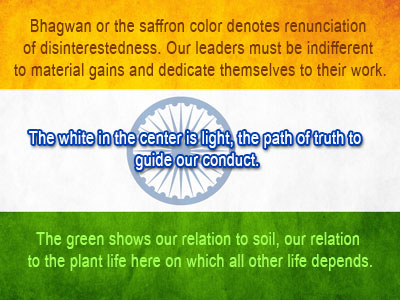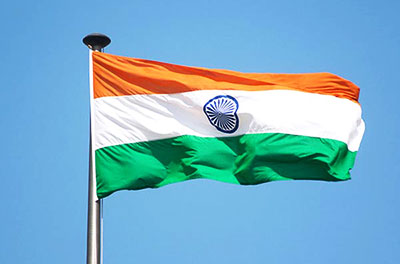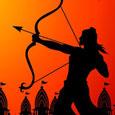Indian National Flag
"Under this flag, there is no difference between a prince and a peasant, between the rich and the poor, between man and women."
-Sarojini Naidu
Preamble of the Flag Code of India says that:
The different colors of the Indian flag are attached with different and respective connotations. Thus the significance of the color and the Chakra in the National Flag was amply described by Dr. S. Radhakrishnan in the Constituent Assembly which unanimously adopted the National Flag. As per Dr Radhakrishnan’s description:-

The Ashoka Wheel in the center of the white band is the wheel of the law of dharma. Thus as per the depiction of this wheel, satya (truth) and dharma (virtue) should be the controlling principles of those who work under this flag. Moreover this wheel also denotes motion for there is death in stagnation. Movement is the epitome of life. Thus in order words India should no more resist to changes, it must move and go forward. Thus the wheel adds dynamism in the peaceful change which India witnessed.
On 15 August 1947 India and Pakistan were created as individual countries. India thus adopted the tricolor of saffron, white, and green with a blue Ashoka Chakra at the centre. Unofficially this tricolour had been the flag of the Indian National Congress. The orange colour represented Hinduism, the green colour - Islam and the white colour represented peace. There was a blue spinning wheel in the center, which represented Gandhiji's call for economic self-sufficiency through hand spinning.
Thus the Indian flag serves as a national treasure and adds to the beauty of the country. Hence every year on the occasion of Indian Independence Day, this tricolor Indian Flag is hoisted on every government buildings. Many patriotic events are as well organised on order to honor those heroic souls who sacrificed their valuable lives.
Moreover it has almost become a customary affair for the Prime Minister of India to hoists the flag and then pay his homage to the freedom fighters who sacrificed their lives in order to give the land their truest freedom. Soon he addresses the Nation on the occasion of Indian Independence Day. Grand parade is as well arranged for which are duly participated by high government officials and military forces.
Children all over do celebrate this national day with active participation and enthusiasm. Almost every school and colleges do arrange for a flag hoisting ceremony and which is duly attended by respective students and teachers. Patriotic songs as well skits and dramas are sung and enacted, thus in a way paying their tribute to those great heroic souls.
Thus on this special day India seems to deck herself with true form of patriotic fervor and passion. Celebrations in every form are visible in every nook and corner of the country. Organizing colorful march-past serves as the flavor of the day. Sweets are distributed and free movie shows featuring Nationalistic and Patriotic movies are shown to the common masses.

Rules for Hoisting Indian National Flag
The National Flag, which is a symbol of the Nation's pride, is respectfully hoisted on the occasion of Independence Day and Republic Day. Some rules have been laid down regarding the usage and hoisting of the National flag in order to prevent its denigration. The Ministry of Home affairs has set up the 'Flag code of India', which governs the usage of the National flag by the citizens.
Some of the Flag codes that needs to be followed so as to avoid insulting this national treasure as as follows:-
- The National flag should always be hoisted at a height and in a suitable manner.
- Whenever the flag is hoisted, it should occupy the position of honour and be distinctly placed.
- The flag should always be hoisted briskly and lowered slowly and ceremoniously. The hoisting and lowering should be simultaneous with the bugle calls.
- Where the practice is to fly the flag on any Government building, it should be flown on that building on all days including Sundays and holidays from sunrise to sunset, irrespective of the weather conditions.
- When the flag is flown during a public meeting, the speaker should face the audience and the flag should be displayed behind and to the right of the speaker or flat against the wall above and behind the speaker.
- When the flag is displayed horizontally or at an angle from the window or balcony, of a building, the saffron band must be upper most.
- When used on occasions like the unveiling of a statue, the flag should be displayed distinctly and separately.
- When the flag is carried in a procession or a parade, it should be held in the right hand. If there is a line of other flags, the National flag should be in the middle.
- When the flag is displayed on a car, it should be attached to a staff, which should be affixed firmly on the bonnet of the car.
- The flag should not be stooped downwards in order to show respect to any person or thing.
- No other flag should be hoisted higher than the National flag.
- The National flag should never be displayed with the saffron band down.
- The flag should not be displayed or fastened in a manner which might damage it.
- The National Flag or any otherimitation of it must not be used for purpose of trade, business, or profession.
- No flag or emblem should be placed either above the National Flag or to its right.




 Ram Navami
Ram Navami Passover
Passover Good Morning
Good Morning